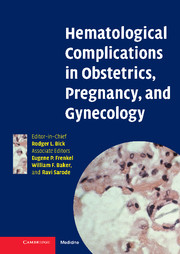Book contents
- Frontmatter
- Contents
- List of contributors
- Preface
- 1 Disseminated intravascular coagulation in obstetrics, pregnancy, and gynecology: Criteria for diagnosis and management
- 2 Recurrent miscarriage syndrome and infertility caused by blood coagulation protein/platelet defects
- 3 Von Willebrand disease and other bleeding disorders in obstetrics
- 4 Hemolytic disease of the fetus and newborn caused by ABO, Rhesus, and other blood group alloantibodies
- 5 Hereditary and acquired thrombophilia in pregnancy
- 6 Thromboprophylaxis and treatment of thrombosis in pregnancy
- 7 Diagnosis of deep vein thrombosis and pulmonary embolism in pregnancy
- 8 Hemorrhagic and thrombotic lesions of the placenta
- 9 Iron deficiency, folate, and vitamin B12 deficiency in pregnancy, obstetrics, and gynecology
- 10 Thrombosis prophylaxis and risk factors for thrombosis in gynecologic oncology
- 11 Low molecular weight heparins in pregnancy
- 12 Post partum hemorrhage: Prevention, diagnosis, and management
- 13 Hemoglobinopathies in pregnancy
- 14 Genetic counseling and prenatal diagnosis
- 15 Thrombocytopenia in pregnancy
- 16 Neonatal immune thrombocytopenias
- 17 The rational use of blood and its components in obstetrical and gynecological bleeding complications
- 18 Heparin-induced thrombocytopenia in pregnancy
- 19 Coagulation defects as a cause for menstrual disorders
- Index
- Plate section
- References
10 - Thrombosis prophylaxis and risk factors for thrombosis in gynecologic oncology
Published online by Cambridge University Press: 01 February 2010
- Frontmatter
- Contents
- List of contributors
- Preface
- 1 Disseminated intravascular coagulation in obstetrics, pregnancy, and gynecology: Criteria for diagnosis and management
- 2 Recurrent miscarriage syndrome and infertility caused by blood coagulation protein/platelet defects
- 3 Von Willebrand disease and other bleeding disorders in obstetrics
- 4 Hemolytic disease of the fetus and newborn caused by ABO, Rhesus, and other blood group alloantibodies
- 5 Hereditary and acquired thrombophilia in pregnancy
- 6 Thromboprophylaxis and treatment of thrombosis in pregnancy
- 7 Diagnosis of deep vein thrombosis and pulmonary embolism in pregnancy
- 8 Hemorrhagic and thrombotic lesions of the placenta
- 9 Iron deficiency, folate, and vitamin B12 deficiency in pregnancy, obstetrics, and gynecology
- 10 Thrombosis prophylaxis and risk factors for thrombosis in gynecologic oncology
- 11 Low molecular weight heparins in pregnancy
- 12 Post partum hemorrhage: Prevention, diagnosis, and management
- 13 Hemoglobinopathies in pregnancy
- 14 Genetic counseling and prenatal diagnosis
- 15 Thrombocytopenia in pregnancy
- 16 Neonatal immune thrombocytopenias
- 17 The rational use of blood and its components in obstetrical and gynecological bleeding complications
- 18 Heparin-induced thrombocytopenia in pregnancy
- 19 Coagulation defects as a cause for menstrual disorders
- Index
- Plate section
- References
Summary
Introduction
Malignancy is an independent risk factor for the development of venous thrombosis (VT) and the latter belongs to the most common and life-threatening complications in patients with gynecological malignancy. Most thrombotic complications are recognized while patients undergo cancer treatment. Breast cancer patients under observation were found to experience VT in 0 to 3% compared to an overall incidence per year of about 0.3% in women. Incidence of VT does not exceed 1.5% following surgery for breast cancer, irrespectively of whether patients had radical or breast conserving surgery. VT occurs in about 1 out of 5 patients after Wertheim – Meigs surgery for cervical and endometrial cancer despite receiving thrombosis prophylaxis and every 4th patient with ovarian malignancy is confronted with VT during the time of primary treatment (surgery and first-line chemotherapy). According to a statement by the Subcommittee Thrombosis and Haemostasis in Malignancy of the International Society on Thrombosis and Haemostasis (ISTH) a 5% incidence of VT can be expected in the course of adjuvant chemotherapy for breast cancer, which is of concern since most breast cancer patients will receive adjuvant chemotherapy. According to the American Cancer Society (ACS) estimates for 2004, 217,000 new cases of invasive breast cancer, 50,840 cases of uterine cancer and 25,580 cases of ovarian cancer will be diagnosed in the United States. Thus some 13,000 patients (6%) with breast cancer, 10,000 patients with uterine malignancy, and 6,300 women with ovarian cancer will develop thrombosis within the first year after diagnosis of cancer.
- Type
- Chapter
- Information
- Publisher: Cambridge University PressPrint publication year: 2006



